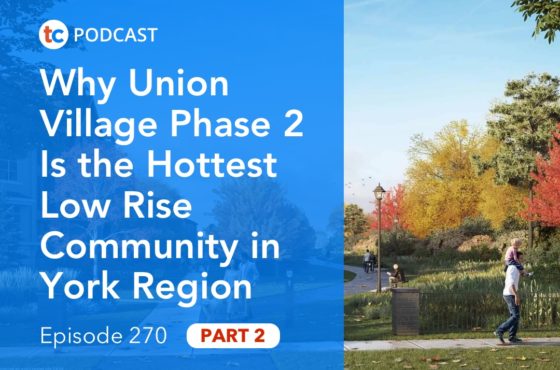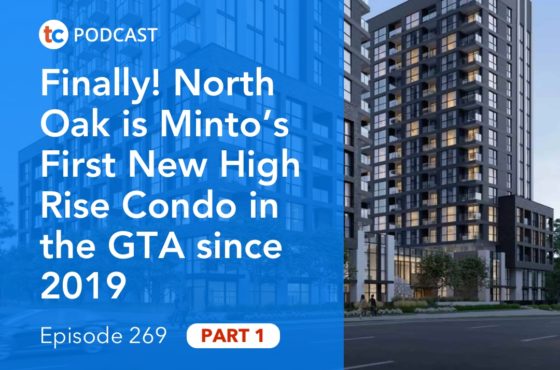The Greatest Mystery in the Toronto Real Estate Market and How to Solve It

Andrew la Fleur breaks down the latest stats from TREB. Sales are up big in the month of April. Good news right? Condo market downtown showing signs of slowing? The greatest mystery of Toronto real estate remains but Andrew offers some ideas on how to solve it.
Subscribe and listen to the True Condos Podcast
Related Links
Click Here for Episode Transcript
On today’s episode of the podcast, we’re going to talk about the greatest mystery in the Toronto real estate market and how we might be able to solve it. Stay tuned.
Welcome to the True Condos Podcast with Andrew la Fleur, the place to get the truth on the Toronto condo market and condo investing in Toronto.
Hey there, and welcome back to the show. Thanks again for tuning in. If you’re a regular listener to the podcast, you probably noticed, haven’t had a lot of episodes in the last little while. Reason being, the spring market is here and things have gotten extremely busy over here at True Condos HQ. And myself and my team, we’ve been extremely busy putting in many, many hours working with many, many different clients at different projects around the GTA.
Things have been great, the market overall is very active, I’d say, after a pretty slow start to the year, the first three months of the year, quite slow. But the last month, the month of April 2019, in particular, was a crazy month, very active, very busy resale, pre-construction, high rise, low rise, everything seems to have woken up in dramatic fashion. I’m not alone in saying this. Talk to any realtor, active realtor, out there and they’ll probably tell you some similar story. The spring market has been extremely active, after a slow start to the year. Maybe weather had a lot to do with that.
Certainly in the pre-construction side, the lack of new launches always has a lot to do with the number of sales that are coming out. Yeah, the stats for the first few months of the year as expected for pre-construction, the numbers were pretty low, pretty down, compared to the past few years. However, that’s directly tied to the fact that very few new projects actually came out and launched. So the majority of units will sell in a project when they launch, at the very beginning stages. If you get launches, you get sales. If you don’t get launches, you don’t get as many sales. So that’s what’s happening there. Certainly when you see the stats for the second quarter of 2019 when they come out, probably in July, we’ll get those numbers, you’ll see that the numbers are dramatically different from the first quarter of the year.
So wanted to give you an update on the market and what’s happening. My take on things, where things stand, looking at some of the numbers here. We just got the stats for the month of April from the Toronto Real Estate Board for the resale market, so we’ll talk about that. And I want to talk about, like I said in the intro, the greatest mystery, as I call it, the greatest mystery in the Toronto real estate market. What that is and how it might solve, or explain, this great mystery. So stay tuned for that as we’re getting into things here.
Overall, looking at the April statistics, made a lot of headlines, caught a lot of people’s attention, in particular … don’t always do these updates every single month, but these stats were very interesting, I thought. Let’s talk a little bit about this here. April resale stats from Toronto Real Estate Board. And, once again, for show notes and links to all these numbers, if you’re interested, you can go to truecondos.com/podcast to get the show notes for this and every episode of the podcast. Also, if you’re not already, most importantly, make sure you are receiving my weekly email updates on the Toronto condo market and Toronto condo investment opportunities. Some of you, it has come to my attention, are regular listeners of this podcast, but you are not getting my weekly emails. Shame, shame. You’re missing out on some really good stuff. You definitely want to sign up with your name and your email anywhere at truecondos.com.
April 2019 stats, the headline basically reads, “Sales are up 17% from last year.” Sales are up 17%, that sounds like a huge number. It is a huge number. It’s a good thing. Market is good, as I mentioned. However, keep in mind that, of course, 2018 real estate market was down considerably from the heavy heady days of 2016 and 2017. Remember it was two years ago that the fair housing plan, as the former liberal government called it, came into place with the foreign buyer tax and a bunch of other things, rent control and a bunch of other things, and put a major wet blanket on the real estate market. So the bigger story, the real estate market has been pretty slow overall compared to the craziness of 2016, 2017. The market over the last couple years overall has been pretty, call it meh, call it middle-of-the-road, call it not too hot, not too cold, sort of lukewarm.
Yes, the condo market has been outperforming, but the low rise market, and particularly, the detached market in the 905 areas has been pretty slow, pretty bad, pretty not great over the past couple of years. So when we’re hearing these numbers of sales up 17%, a lot of that is driven just by the fact that we’re comparing it to a slower time period of last year. Still, good news. But when we look at prices, prices are up only 1.9%, this is overall for the entire market, all houses, all condos, everything all jumbled together. Sales up 17%, but prices only up 1.9%. Again, that gives you a pretty good indicator of what I’m saying, that, yes, things are looking good, but it’s not … remember the days of two years ago. Prices were up like 33%, 35%. Some pockets were up 40% in a year, 1.9% prices are up. So overall, market is fine, market is good. Market is somewhere between a balanced market and a seller’s market in an overall sense.
So a lot of this has been driven by, what’s driving this? A lot of what’s driving the increase is the low rises, the 905, or detached houses are up 22%. Interestingly, condos in the 905 are up about 17% in sales versus condos in the 416 are only up 2.6%. Very interesting. Obviously, affordability is a big, big factor in this market. Condos in the 905 are the most affordable product type in our marketplace overall, so that is seeing a big bump. But, at the same time, detached homes in the 416 are up 21%. Detached homes in the 905 are up 22%. So you’re seeing it on both ends of the thing here, where really everything is doing well, interestingly, but except the condo apartments, condos in the 416. Again, still doing fine, up 2.6%. But again, part of what’s the story there is that condo sales over the past couple years have been doing very, very well and the numbers are way up, and generally speaking over the past couple of years versus before. So as the low rise market slowed down, the condo market has still been strong and doing well.
That’s the big picture, broad picture, but, as always, I want to focus primarily this chat and my analysis, and as I’m studying the market, I’m primarily looking at what’s happening in the downtown condo market. That’s the area of most interest and something that I’ve been tracking for 12 years. Looking at the downtown condo market, again, sales are down, sales are down from the previous year, they’re down a little bit. But the flip side of the coin is that inventory is way down, so the number of condos for sale is way down. Still, it’s a very strong seller’s market. Is it a buyer’s market? Is it a balanced market? Is it a seller’s market? It’s still, the downtown condo market is still very much a strong seller’s market.
The sales to listing ratio is 68%. Again, sales to listing ratio is that, if you’ve been listening to the podcast, you know that’s my favorite statistic. That is the number that I always go to, to get a temperature of the market and also the direction of the market. That one number tells us so much. So I always look at that number to get a sense of what’s going on. And again, historically, most of the time, over the last 10 to 15 years, the sales to listing ratio for the downtown condo market has been somewhere around 30 to 40%, most of the time. That is a balanced market. When you’re getting above 40%, you’re getting into seller’s market. When you’re getting above 50%, you’re getting into strong seller’s market. When you’re getting into the region we’re in now, which is 68%, it’s a very strong seller’s market.
So what else? Prices are up in the downtown market, prices are up in this year so far versus last year. They’re up around 5 to 10% depending on how you slice the pie. So prices are still going up, they’re still going up at a higher than historical average. Again, historical average is probably, for the last 10, 15 years for condos, it’s probably more like 3, 4, 5% as what we’re used to and what’s normal. So if we’re up in the 7, 8, 9% range, we’re still well above average. And why is that happening? Again, it’s the seller’s market, the sales to listing ratio is still way up there. So there’s still not enough supply for what the demand is calling for, so prices are rising and we can expect they will continue to rise, as long as that sales to listing ratio stays up there, prices are going to continue to rise.
Remember, prices were rising when the sales to listing ratio was 30%, 32, 34%, these kind of numbers. Prices were still rising, even at 2%, 3%, small rises, but they’re still going up, even at that low number. So we’re way above that number. We’ve been way above that number for the past couple of years now, strong. Market, amazingly, even though prices have gone up so much, they’re still continuing to go up. They’re not going up as much as they were. We’re not going up by 20, 25, 30%, we’re not going up, like we saw before, we’re not going up even by … we’re not in double digits. We’re not going up by double digits, but we’re still going up by high single digits. The market is still strong and it’s hot and it’s still a seller’s market.
So again, historical context going back, so 68% sales to listing. I’ll list you the previous, like the last four years before this year, same month. So 88% was last year, very high, not as high as that, but still very high. The crazy heady days of 2017, it was 103%, which doesn’t even make mathematical sense, but there we are. And 2016, it was 49%, that was when things were starting to heat up, most of the action was still in the low rise market, but the condo market was starting to feel that. And then going back to, say, 2015, more of a representative year of the previous 10 to 15 years, downtown condo market was at 34%. Again, that 30 to 40% number that I said is what was normal for most of the time in the last 10 to 15 years, that’s where things were at. That’s the last sort of normal year, back in 2015.
So we’re trending more towards normalcy, but we’re still way above it, we’re still in a strong seller’s market. Sales are down, the number of sales are down, but, as I said, the sales to listing is still high so that means the inventory, the supply, is down. So the supply, again, historically, normally downtown condo market supply over most of the last 10, 15 years well over 1,000 condos available for sale. Looking at, say, 2011 to 2016, that period there, available supply was around 1,500 to 2,000 condos available for sale at any given point in time. That was a normal range on the supply side, 1,500 to 2,000. Right now, today, we only have 800, 800 units in the entire downtown core available for sale, a very low number compared to historical. Higher than it was last year, last couple of years, a little bit higher, but still extremely low compared to historical norms.
So again, seller’s market, prices rising, but this leads me to the biggest question. This is the core of the podcast and the title which the big question remains, why is the supply so low? Why is nobody selling? To me, this is the great mystery of the Toronto real estate market. We see this in a lot of segments of the market in the core of the city especially. Where is the supply? Why is nobody selling? The real estate bears have been scratching their heads on this one forever, these guys who are sitting there waiting for the whole market to crash. Well, guys, if you want the market to crash, we need to see that supply number skyrocket. We need to see supply go dramatically higher. It’s just not happening. In fact, it’s trending in the opposite direction.
Hate to be the bearer of bad news, Bad News Bears, but that’s the reality. So again, this is, as I call it, this is the greatest mystery of Toronto real estate. Why, even though, the Fair Housing market and everything came in and we see what’s going on, and Vancouver market is falling down and stuff, yet Toronto, here we are just years and years are going by and we’re still trucking along, still rising, still rising. What’s going on? Why is nobody selling? Why do we never see that inventory number get up there? Why is it, in fact, going down? We have more, in the condo market, we have way, tens of thousands of more condos exist today, than they did five years ago, yet the supply of condos available to purchase is less than half of what it was.
So what’s going on here, and what’s happening with this mystery? How do we solve it. I don’t think there’s a definitive answer on that, but here are four ideas that I have that I think are forces acting in favor of low supply. Number one is that transaction costs are so high. Transaction costs, particularly in 416, you have the double land transfer tax. It’s the only municipality that I’m aware of in North America that has this double land transfer tax. Maybe there’s probably some others, but let me know if you know of any, certainly not any in Canada. Transaction costs, extremely high, any time you sell a property. Or if you’re thinking of moving, selling, and buying again, and moving, moving expenses, it’s very, very high. Commissions that you’re paying, obviously, to your real estate agents when you’re selling, is very, very high. Property prices are high, commission amounts go up with it as well.
I think there’s a massive amount of people, it’s really causing people to pause and say, “Do I really want to move if it’s going to cost me 50,000 dollars, 80,000 dollars, 100,000 dollars, is it really worth moving or should I just put that money back into my house, do some renovations, maybe an addition or maybe just go on some crazy vacations and buy a nice care instead.” So land transfer tax alone, obviously, is also a huge factor. The higher the prices go, the higher that percentage is and it’s gotten even … they increased it even more recently. If you’re selling the average home in Toronto around 1,000,000 bucks and you want to buy another one for, say, 1.5 or something, the land transfer tax you’re paying is absolutely astronomical and insane.
People are saying, “What benefit do I get from paying that tax? Absolutely nothing. It’s just purely a cash grab.” I think that’s a huge factor is just the transaction cost of moving in this city are so high, in particular in the 416 and particular in the core of the 416. That’s really causing people to pause and to say, “You know what? I don’t want to sell.” I think also, people generally are positive about Toronto real estate in the long term and so people that own real estate are generally disposed to holding onto that real estate and not dumping it and getting rid of it. I think that’s also part of it too.
The second thing is, rents are very high. Rents are high and they’ve gotten much higher in the past few years. So that means investors are more predisposed to not selling their properties because … even if you’ve got somebody, an old tenant in there that’s way below market value, you know that the second that tenant moves out, and eventually he’ll move out, you’re going to see a massive bump in the rents that you’re getting from that property, massive increase in cash flow. Investors who are getting those high rents are happy and they’re enjoying it and they’re paying their bills. Investors who have had tenants long term and they’re getting lower rents, they know that the moment that they move out, they’re going to get those high rents. They see that rents are continuing to rise so that’s causing investors to say, “You know what? I’m just going to hold these properties.”
The third thing, the stress test. The stress test is a huge factor because the stress test is limiting what people can borrow and it’s preventing people from moving up the housing ladder. It’s become much harder to move up the ladder compared to before the stress test, it was much easier. You bought a property some years ago, you want to move to a bigger one, you’ve got tons of equity, but you can’t afford to make that jump to the next level because of the stress test. So what do you do? You don’t sell, you stay in place. And again, that’s preventing supply from coming on the market.
Finally, I think the fourth factor is, just in general, the economy is strong. People are employed, people have income, people are not losing their jobs. That means that people are not being forced to sell for economic reasons when there’s a market downturn, when there’s a recession, when people lose their jobs. That causes some people in the population to be forced to sell their homes because they can’t afford to pay their mortgages and we’re not seeing that at all. So again, another factor that’s reducing the amount of supply that’s out there.
So, there you go, that’s my take on what’s happening in the market right now and talking about the greatest mystery of why there’s no supply. Why is there only 800 condos available for sale in 2019 downtown when in 2015, there was 1,800 condos for sale. Those are some of the reasons why I think that’s happening. Ultimately, there’s a lot of red tape in the system, both for injecting new supply into the system if you’re a builder, we talk about that a lot in this podcast. And also injecting new supply into the system in the resale market, as I just discussed for a while, between land transfer taxes and rent controls and stress tests and all these things. All these layers of government bureaucracy and red tape, ultimately, they ultimately benefit us as condo investors, as real estate investors. They create a situation of reduced supply and they create situation of higher rents and increasing rents.
So ultimately, in a strange and backwards sort of way, we’re thankful for all this red tape and all this bureaucracy as investors, investors who are already in the market. It’s hard if you haven’t gotten into the market yet, but for us investors who already in the market, these things are ultimately, in a strange and backwards way, good for us.
That’s where the market stands today. I hope you find some value from this episode. I hope you learned something new. And again, make sure you’re receiving my weekly email updates for more information about the condo market and specifically for investment opportunities in the condo market, some great ones coming up in the weeks ahead. Looking forward to sharing those with you, my email subscribers.
And once again, have a great week and happy investing. Until next time, bye.
Thanks for listening to the True Condos Podcast. Remember, your positive reviews make a big difference to the show. To learn more about condo investing, become a True Condo subscriber by visiting truecondos.com.







